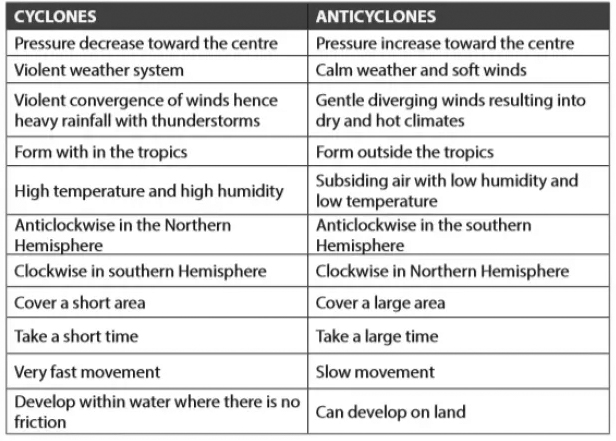- Home
- Prelims
- Mains
- Current Affairs
- Study Materials
- Test Series
 Latest News
Latest News
 EDITORIALS & ARTICLES
EDITORIALS & ARTICLES
Polar Anticyclone
- A polar anticyclone is a high-pressure system that forms over polar regions by sinking cold air; it peaks in winter because of radiative heat loss.
- It is a cold-core high with maximum strength close to the surface, driven by cold, dense, sinking air.
- Sinking cold air increases surface pressure, creating stable conditions with clear skies, fog, frost, and sharp nighttime cooling.
- In winter, they migrate eastward and equatorward due to pressure shifts, bringing cold air to lower latitudes. In summer, they move equatorward, causing cool, dry weather.
- They interact with polar fronts, forming cold fronts that cause storms and temperature drops.
- Notable Examples: Siberian High (Eurasia), Canadian High (North America), and the Antarctic High.
Formation Process
- Surface Cooling: Surface cooling raises near-surface air density, causing cold, heavy air to sink.
- Pressure Buildup: Cold air sinks, compresses, and warms, remaining dense and raising surface pressure.
- Rotation: Accumulated air diverges and deflects by the Coriolis force, forming a rotating high.
Contribution of Polar Anticyclones to Northern Hemisphere Circulation
- Source of Cold Air Masses: They generate dense, cold air that spreads equatorward, influencing mid-latitude weather systems.
- Support Polar Cell Dynamics: Their descending air reinforces the polar cell, aiding heat balance by moving cold air south and drawing warm air north.
- Trigger Cold Waves: As they migrate southeast in winter, they cause cold wave outbreaks in Asia, Europe, and North America.
- Block Westerly Disturbances: Persistent polar highs can obstruct mid-latitude cyclones, leading to prolonged cold or dry conditions.
- Strengthen Pressure Gradients: They enhance high-to-low pressure differences, driving strong polar easterlies.
- Affect Jet Stream Patterns: Their presence can distort or displace the jet stream, influencing storm tracks and temperature anomalies globally.
Impact of Polar Anticyclone
Global Level
- Jet Stream Disruption: Polar anticyclones distort the jet stream, causing events like the 2021 Texas cold wave and prolonged European heatwaves.
- Blocking Patterns: Stable anticyclones form atmospheric blocks, triggering multi-week floods in Asia or droughts in Europe. E.g., the 2022 European heatwave.
- Arctic Amplification and Feedback: Faster Arctic warming reduces albedo and intensifies anticyclonic feedbacks, contributing to global temperature rise (IPCC).
- Cold Air Outbreaks in Mid-Latitudes: Southward anticyclone shifts brought record lows to Eastern U.S. in 2019, with temperatures plummeting below −30°C in parts.
- Impact on Ocean Currents and Sea Ice: Strong polar highs altered wind patterns, contributing to a 13%/decade decline in Arctic sea ice since 1979 (NSIDC).
On India
- Cold Wave Outbreaks: Cold surges from polar highs cause severe cold waves in north India. E.g., Delhi recorded 3.5°C in Jan 2023, disrupting schools and transport.
- Blockage of Western Disturbances: Polar highs deflect western disturbances, reducing winter rain/snow. E.g., Kashmir saw 35% deficient snowfall in winter 2022, affecting water supply for agriculture.
- Temperature Inversions & Pollution Traps: Stable anticyclones cause air stagnation and pollution. E.g., Delhi’s AQI exceeded 450 in Jan 2024 due to trapped PM2.5 under inversion layers.
- Frost-Induced Crop Loss: Sudden temperature drops lead to frost, damaging Rabi crops. E.g., mustard and potato crops in Rajasthan and UP were hit by frost in Jan 2022.
- Delayed Monsoon Withdrawal/Winter Onset: Extended anticyclonic conditions delay seasonal transitions. E.g., 2021 monsoon withdrew 10 days late, affecting sowing in Punjab and Haryana.
Polar anticyclones are crucial drivers of global atmospheric circulation but increasingly contribute to weather extremes and seasonal disruptions. For India, adaptive agriculture, early warning systems, and pollution control are vital to mitigating their winter impacts.










 General Studies
General Studies